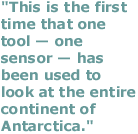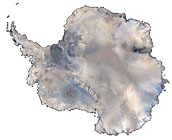

 |
by Mike Meshek September 24, 1999 |
||
|
The view of Antarctica, typically a very cloudy continent, was made clear in 1996 by two new geophysical products: a satellite image map and a three-dimensional digital data set. By combining cloudless satellite imagery with digital elevation data, the new products reveal subtle surface features previously not perceptible and thus offer a wide range of applications, from field work planning and navigation to scientific research and analysis to geologic and glaciological mapping.
|

 Previously uncharted features of the Antarctic Plateau are clearly visible on new maps. (Image courtesy of U.S. Geological Survey, click here for more Antarctic imagery from USGS) For more information, visit the Land Processes Distributed Active Archive Center. (A new browser window will open.) |
"This is the first time that one tool — one sensor — has been used to look at the entire continent of Antarctica," said Jane Ferrigno of the U.S. Geological Survey's National Center. Prior to the advent of the Advanced Very High
Resolution Radiometer (AVHRR), no other civilian satellite remote sensing system was able to view the entire South Pole area, she said. Using cloud-free AVHRR imagery, Ferrigno and a team of other USGS investigators produced the clearest view of Antarctica ever seen.
Pat Chavez and his group at the USGS' Flagstaff Field Center performed the digital image processing necessary to combine and enhance the map components. Working with an existing AVHRR imagery mosaic, Chavez, Ferrigno, and colleagues first selected and compiled cloudless images taken between 1980 and 1994. These were then electronically blended and "colorized" to improve the presentation of surface and structural features. Then using the cloud free AVHRR image mosaic and a digital elevation model distributed by the Land Processes DAAC at the USGS' Earth Resources Observation Systems Data Center, Chavez and his group then introduced topography, the map's third dimension. Finally, Chavez and his team further enhanced the map's topographic component by creating stereoperspective views for the digital version. Never before seen on maps, faint features of the Antarctic Plateau (the massive upland of ice that reaches elevations of 4,000 meters and constitutes the continent's eastern half) are now clearly visible on both versions of the new map. From a glaciological perspective, significant regional flow features, such as the West Antarctic ice streams, are discernible on paper for the first time, said Ferrigno. Also making their first map appearances are indications of large-scale subsurface geologic structures formerly hidden under huge, blank white spaces on seemingly flat older maps. The new map may thus answer geologists' and glaciologists' questions about the structure and flow of certain features, but also raise new research questions, said Ferrigno. As one of the more poorly-mapped regions of the planet, Antarctica has historically posed challenges for researchers planning field experiments. Although the new map does not provide enough detail to show small features, like crevasses, field scientists will now have an additional resource for planning large regional research projects or continental traverses, according to Ferrigno. The USGS map has already been used by non-scientists. The British Broadcasting Company (BBC), for example, has used the map to plan progress reports on Antarctica's latest summer field season, said Chavez. Additionally, Ferrigno said American students have used the map to help locate themselves in virtual classrooms of the Antarctic. Previously uncharted features of the Antarctica Plateau are clearly visible on the new maps. Soon after the USGS released the paper map in June 1996, Chavez began work on a digital version for the World Wide Web, the source of the BBC and virtual classrooms' Antarctic work. "The things you see in the Web version, like stereoperspectives and color composites, come from the flexibility you have in the digital world," said Chavez. The digital version includes other advantages. During virtual tours of Antarctica, nonscientists are able to zoom in on and out of the image. More importantly, researchers can electronically manipulate the data to meet the needs of their particular analyses. "One of the things that some researchers are doing is taking the data produced for this map and adding other data to it," said Ferrigno. "Using the map data and other data, including other AVHRR scenes, you can get a result which is better than all the individual parts." Ferrigno and her USGS colleagues, for example, are combining the AVHRR map data with Landsat data in a study of the Antarctic coastline. The Landsat data, which are finer in resolution but not available over the entire continent, will complement the coarse resolution AVHRR data. By combining the two data types, the scientists will attain the necessary detail (when available) within the larger perspective of all of Antarctica. Working at the coastlines, Chavez said, researchers can also use the digital map data to isolate, and thus measure, the areal extent of sea ice and ice shelves. The numerous applications of the new map flow from the clear view it provides of the planet's largest ice sheet, said Ferrigno. "We're pleased to have produced such a valuable scientific product."
|
|